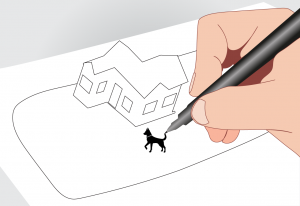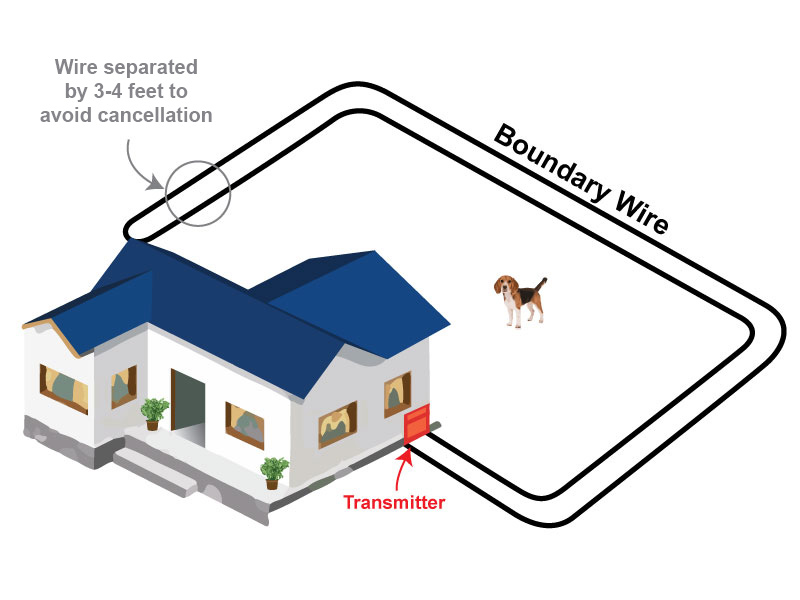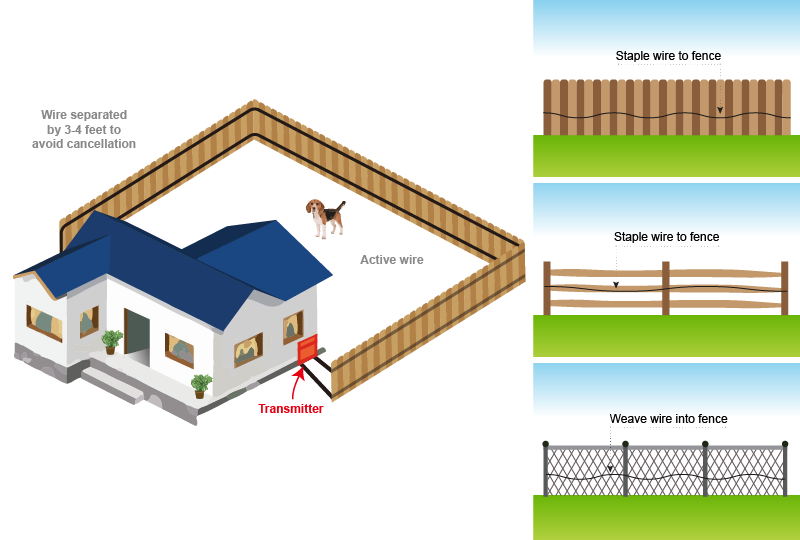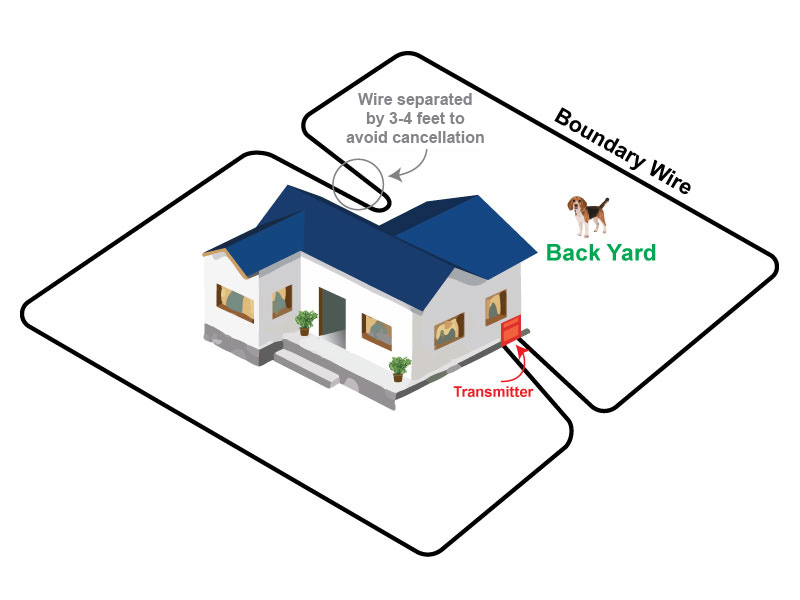How to Install a Wireless Fence for Dogs
Step 1 Planning the Installation
Mark Your Utilities and Obstacles

To have your utilities marked, simply call 811. They will come out and mark your underground utility lines with spray paint or flags. Call early, as it may take up to a week for them to come out.
Should you have any privately-installed utilities, such as gas cylinders or a septic system, these will need to be marked as well. Since underground utilities are generally buried over a foot deep, whereas your wire is only buried a few inches down, hitting these underground utilities usually isn't an issue.
With that being said, you need to make sure that if your dog fence wire is running parallel to any underground lines, that you separate your dog fence wire from them, by about 4 feet. However, crossing underground lines perpendicular is no problem.
If possible, also mark the location of any low-voltage power outdoor lighting lines, or sprinkler systems as well. If you don't know where these lines are located, make an educated guess. You don't want to damage a sprinkler line or low voltage power line. You may decide if you wish to shut off the water and the power before you begin digging, if you aren't certain where these lines are located.

Principles of Design
Here are some things to keep in mind when you are planning how to place your wires:
Utility Lines Should Be Crossed at Right Angles
You need to make certain that you don't run wire close to a utility line for an extended stretch. This is because in some instances, a boundary wire running close to a utility wire can cause your dog fence collar to activate where it shouldn't.
Round Your Corners
The corner of your dog fence wire should be gradually rounded, avoiding any sharp 90 degree turns. Otherwise, the signal in that area could cancel out.
Establish Separation Between Parallel Dog Fence Wires
Each length of boundary wire emits a signal. If they are running too close together, they will cancel each other out. For this reason, any boundary wires running parallel to each other need to be separated by at least 4 feet. In addition to this, if your neighbors have an electric dog fence, you need to keep your wires separated from theirs by about 6-10 feet.
Diagramming Your Yard


On a piece of graph paper, draw a rough sketch of your property. It should show any buildings, sidewalks, driveway, gardens and underground utilities. This is so you can figure out where you would like your dog to have access to, and which parts you want him to not have access to.
Make a decision of where you are going to mount your transmitter box. Ideally, it should be located near a power outlet, and must be protected from the elements. The garage is a great place, or perhaps an outside shed that has power going to it.
Next, determine where you will lay out your dog fence wire, using the diagrams below. Your dog fence needs to make a complete loop that starts and ends in the same location. You can use twisted wire to connect your two ends of boundary wire with your transmitter. When twisted wire is used in this way, it allows your dog to cross over it without receiving a correction. More information on twisted wire.
Sample Layouts
1. Whole Yard Perimeter

The most widely used layout for a dog fence makes a single loop around your property. Your dog has access to the entire property and the twisted wire connects to the main control box. Your dog can travel all the way around your home with no escape points.
2. Backyard only dog fence layout: The Double Loop

The challenge of enclosing your backyard only is that if you were to create a solid loop with your boundary wire around your backyard, your dog wouldn't be able to get out the back door without being corrected. Logically, this is not what you want. What to do? The answer is a double loop. Here is how it works. You go around 3 sides of your yard, then double back on the first wire you put down, laying the wires parallel to each other. You just have to be sure to separate the parallel wires by at least 4 feet. If you don't, you won't get a nice strong signal along the boundary. In addition to this, you may have dead spots where there is no correction at all. Do you already have a fence in place? In this situation, you can simply begin by running your dog fence wire along the bottom of the fence, and then come back to the transmitter by running the wire along the top of the fence.
3. Double Loop on an existing fence

Gate Installation Options

Perhaps you already have an existing fence and you just need to stop your dogs from jumping over it or trying to dig underneath it. Does your existing fence go around your backyard only? If so, the right layout for you is a double loop on an existing fence. Here is how it works. Starting at your transmitter, you run your first wire on the bottom of the fence. Then, you come back to your transmitter, running your wire along the top of your fence, which essentially separates your wires by 4 feet, coming back to your transmitter.
4. Over The House Method

Another thing you can do if you need to contain your backyard only is to run the dog fence wire up high over the back of your house. Begin by running the wire up a downspout on one side of the house, across the gutter, and down the downspout on either side of your house. This vertical height over the ground allows enough space for your dog to get in and out of the back door without being corrected. As always, you need to check your collar to make sure that it isn't being triggered when your dog comes in and out. Also test rooms near the line of the gutter to make certain there is no signal spilling over into those rooms. If there is, turn down the setting of the boundary width on your transmitter until it doesn't happen anymore.
5. Backyard Only: The Pinch Method

Again, the challenge of a backyard only layout is that you need the house side of the boundary to be inactive, so that your dog can enter and exit your home freely. In order for the fence to work, you must have a full loop of single (NOT TWISTED) wire. The pinch method is another approach you can take.
The way to make a complete loop, while only giving your dog access to the backyard is to make a loop that goes tight around the front of the house as well. This allows you to complete the loop. However, since it is running tight around the front of the house, it doesn't allow space for your dog to roam in the front yard.
However, when you do this kind of layout, it is important to do a quick check with the collar inside of the house to make sure that the signal isn't inadvertently spilling into the house in rooms where the dog will be living. Should there be a problem, just decrease the boundary width, or you can just move the wire a little further away from your house.
6. The Hourglass layout

In some cases, dog owners want their dog to be contained in their front and back yards, but don't want their dog to be able to cross freely in between the two. Notice that the 2 loops are connected to each other on the left hand side of this diagram, and that they both meet up at the transmitter on the right hand side. As a side note, where the wires are close to each other, creating the center of the hourglass, you need to make sure that they are at least 10 feet apart so that there won't be interference with the signal.
7. Avoidance Areas within the perimeter

Giving your dog access to your property but not your garden or other areas is easy with an internal lake loop. Lake loops within the perimeter create "no go" zones by connecting to the main perimeter via twisted wire that your dog can freely cross without a correction. You can also use an extra dog fence transmitter of the same brand as your main loop transmitter to create a smaller distance based signal field than the one you have set for the containment barrier. Avoidance areas can be set to a much lower field range than your actual containment field. For example: Supposing you have a 100 pound Great Dane and you have a six foot field set up to contain him, it might take six feet to keep him in the yard, but it would only take about a 6 inch field to make him avoid flower beds or off limit areas. You could set two customized transmitters up sending out different ranges. The containment field would be six feet and the avoidance field would be connected to a different boundary wire system but only have a field range of 6 inches or so.
8. Gate or Escape Point installations

In certain instances, the main purpose of the installation is to keep your beloved pet from escaping from a fence gate or opening. You can certainly make this happen with an electric dog fencing system. All of the fundamental rules of installation apply to installing a small section of protection as they would for a whole yard installation. This includes completing a loop, twisted wire and installing a main control panel next to an outlet. The illustrations below demonstrate how protection can be provided for almost any escape point on your property.
With this layout, you can simply run a piece of twisted wire from your main dog fence transmitter to the gate opening or escape point. Simply run a small loop around this area separating the wires by at least 2-4 feet. This area will now be active and prevent your dog from escaping through this area.
9. One-Sided Boundary

Perhaps you live in a rural setting, and all you need to do is protect your dog from going out into the road. In this case, the one-sided boundary layout is what you need. You simply run a long length of twisted wire from the transmitter, out to the road. Next, you create a long skinny loop, remembering to keep the parallel sections at least 4 feet apart so that the wires won't interfere with each other. It is important to run your loop far enough along the road so that your dog won't run around it. The only stipulation to this layout is that the twisted wire can only be half the length of the looped boundary wire. For example, if you have a loop that is 100 feet in a circle, you can only run 50 feet of wire back to the transmitter.
10. Avoidance Areas as the main function

You can use your electric dog fence not only to keep your dog in but also to keep your dog out of sensitive areas of your property. Multiple loops connected by twisted wire can allow you to create multiple 'no-go' zones on your property. An unlimited amount of off limits areas can be created with this application. This type of install is ideal for somebody who already has a fenced in backyard and wants to keep the dog away from certain areas.
11. Two-Sided Layout

This layout involves creating 2 separate double loops, and connecting them with twisted wire. This allows your dog access in and out of the back of your house, plus it allows access to the back of your property.
Should you have enough yard space, you can use a double loop approach to create a boundary that is three-sided. Just don't forget to have the ends of it into the lake when doubling back so that your dog won't be able to run around the side of the fence.
12. Waterfront Limited Water Access

If you have a lakefront property, or if you would like to give your dog access to the lake, you have several different options. Please note that there is no danger of your dog getting electrocuted while swimming. Your dog's level of correction won't change or pose any sort of safety threat. When you incorporate the lake, you need to know if your lakefront drops off, or gradually gets deeper. It depends on what you are trying to accomplish as to how you will lay the wire to incorporate the lake. When you are sinking the wire, it is recommended to run it into a water hose and sink it to the bottom of the lake. This will further protect the wire from fishing hooks and critters.
Simply submerge your extra boundary wire into your lake, at the distance out that you desire. Perhaps you just want your dog to just be able to walk into the lake a few feet for a drink, or to lay down and cool off in the water. Or, perhaps you prefer sinking the wire down 10 feet so that your dog can go for a deeper swim? Depending on your goal, you can decide how much wire you need to sink.
13. Waterfront Dock/Boathouse option

This layout is a modification of the first, just incorporating a dock and a boathouse. In this situation, the lake isn't incorporated in the planning of the fence.
14. Double Loop with water access

If you have enough space in your yard, you can use a double back around to create a three sided fence boundary. Set an extra length into the lake when doubling back so that your dog will not be able to easily run around the electric dog fence.
How to Install a Wireless Fence for Dogs
Source: https://www.extremedogfence.com/planning-your-layout/